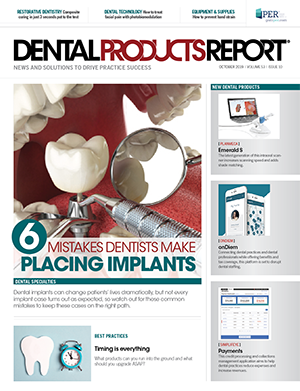Closer Look: Composite curing in just 3 seconds put to the test
Testing at the UAB School of Dentistry shows Ivoclar Vivadent’s 3s PowerCure™ System is efficient and effective.

Dr. Nathaniel Lawson

As an educator and researcher, Dr. Nathaniel Lawson puts his dental degree and his doctorate in biomedical engineering to work testing the mechanical properties of dental materials both in his lab and in the research clinic at the University of Alabama at Birmingham School of Dentistry where he serves as the director of the Division of Biomaterials.
In this capacity, he first encountered the 3s PowerCure System from Ivoclar Vivadent. This system incorporates Adhese® Universal single-component adhesive, Tetric® PowerFill, and Tetric® PowerFlow composites, and the Bluephase® PowerCure LED curing light and is designed to add efficiency to the placement of posterior composite restorations.
As with any new material or system that comes into his lab, Dr. Lawson says he approached the system with a dose of skepticism. With the 3s PowerCure System, he was curious about how well the light completely polymerizes the composite with a 3-second cure cycle. After trying the system, Dr. Lawson says he was impressed.
“My first concern was the ability of a curing light to fully polymerize composite at the claimed 4 mm depth with only three seconds of curing,” he says. “Luckily, it is easy to measure depth of cure in the lab and we were able to confirm the reported depth of cure.”
The benefits of this rapid curing cycle were immediately apparent. Dr. Lawson notes that curing is a part of the workflow where clinicians tend to rush, and the 3s PowerCure System helps alleviate this rush.
“All practicing dentists know how tempting it is to cut short the light-curing time as we grow impatient to move to the next step of the procedure. I think this is because light curing is a passive procedure whereas many of the other active procedures are more engaging,” Dr. Lawson says.
With the 3s PowerCure System both the materials and the light feature design elements that work in concert. The Bluephase PowerCure LED curing light features an output of 3,000 mW/cm2, approximately three times the output of a traditional curing light. However, Dr. Lawson explains the system works because the composite is formulated with alternative light initiators.
“When traditional composites were cured with high-power curing lights for shortened curing times, fewer polymerization initiators were activated,” Dr. Lawson says. “The novel technology in the PowerCure 3s system is a new initiator in the composite.”
Dr. Lawson and a team of researchers are conducting a clinical trial with the 3s PowerCure System. In this trial, Tetric PowerFill produced acceptable to excellent marginal integrity.
Dr. Lawson mentioned other research teams have shown the 3-second cure cycle generates equivalent heat as traditional lights with a 20-second cure cycle. Additionally, they did not observe higher than normal incidence of post-operative sensitivity among patients.
Through his testing of the system, Dr. Lawson believes the 3s PowerCure System can help make posterior composite placement more efficient, and the shortened curing time can also help clinicians be more effective while curing because it can reduce the possibility of the light moving while curing. In fact, the Bluephase PowerCure LED curing light features a sensor to alert a clinician if the light drifts too far from the ideal position while in use.
“Many clinicians can relate to the experience of noticing a curing light drift from its original position if the operator holding the light is not focused on maintaining this position,” Dr. Lawson says.
While the system has shown impressive properties in testing, Dr. Lawson said there are still areas to be explored. The 3s PowerCure System is designed for posterior teeth, and the 3-second cure cycle has not been tested on deciduous teeth, so this cycle should not be used with younger patients.
Additionally, the 3-second cure cycle is designed specifically for use with the corresponding materials. When using the light with other materials, it is important to follow the recommended curing times.
